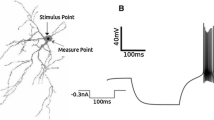Abstract
Recordings made from decerebrated, paralyzed eels (Anguilla anguilla) producing rhythmical spinal motoneuronal activity showed that around 65% of identified reticulospinal units, belonging to the inferior reticular division, discharged rhythmically. The reticulospinal bursts, lasting from 300 up to 3000 ms, were in time with spinal motoneuronal bursting activity. In different fish the modal cycle period varied between 2 to 4 s and burst duration and firing frequency of each neuron showed large changes from cycle to cycle. Burst responses similar in form to those occurring spontaneously were evoked from reticular neurons when the ophthalmic nerve was stimulated regularly (intervals of 1 to 10 s) but the cycle period, firing frequency and burst duration were now more predictable. For stimulation intervals between 2 and 5 s, each ophthalmic nerve stimulus was normally followed by a burst from the reticulospinal neuron. The cycle period of the reticular rhythm then became equal to the interstimulus interval and the reticulospinal unit was entrained by the stimulus. Beyond this range of interstimulus intervals, complete entrainment was lost. We suggest that regular sensory input provides a powerful stabilising influence to rhythmically active motor systems in the brainstem and spinal cord.
Similar content being viewed by others
References
Aoki M, Mori S (1981) Locomotion elicited by pinna stimulation in the acute precollicular-postmammilary decerebrate cat. Brain Res 214:424–428
Armstrong DM (1991) Approaches to studying supraspinal contributions to the neural control of mammalian locomotion. In: Armstrong DM, Bush B (eds) Locomotor neural mechanisms in arthropods and vertebrates. Manchester University Press, Manchester, pp 245–259
Cruce WLR, Newman DB (1984) Evolution of motor systems: the reticulospinal pathways. Am Zool 24:733–753
Drew T, Duboc R, Rossignol S (1986) Discharge patterns of reticulospinal and other reticular neurons in chronic unrestrained cats walking on a treadmill. J Neurophysiol 55:375–401
Duboc R, Grillner S (1989) The role of spinal cord inputs in modulating the activity of reticulospinal neurons during fictive locomotion in the lamprey. Brain Res 483:196–200
Eaton RC, DiDomenico R, Nissanov J (1991) Role of the Mauthner cell in sensorimotor integration by the brain stem escape network. Brain Behav Evol 37:272–285
Gray J, Sand A (1936) The locomotory rhythm of the dogfish (Scyllium canicuta). Exp Biol 13:200–209
Holst E von (1935) Erregungsbildung und Erregungsleitung im Fischrückenmark. Pflügers Arch 235:345–359
Kasicki S, Grillner S, Ohta Y, Dubuc R, Brodin L (1989) Phasic modulation of reticulospinal neurones during fictive locomotion and other types of spinal motor activity in lamprey. Brain Res 484:203–216
Meredith GE, Roberts BL, Maslam S (1987) Distribution of afferent fibers in the brainstem from end organs in the ear and lateral line in the European eel. J Comp Neurol 265:507–520
Noga BR, Kettler J, Jordan LM (1988) Locomotion produced in mesencephalic cats by injections of putative transmitter substances and antagonists into the medial reticular formation and the pontomedullary locomotor strip. J Neurosci 8:2074–2086
Orlovsky G N (1970) Influence of the cerebellum on the reticulospinal neurones during locomotion. Biophysics USSR 15:928–936
Paul DH, Roberts BL (1984) The activity of cerebellar neurones of the decerebrate dogfish Scyliorhinus during spontaneous swimming movements. J Physiol (Lond) 352:1–16
Roberts BL, Ballintijn CM (1988) Sensory interaction with central “generators” during respiration in the dogfish. J Comp Physiol A 162:695–704
Roberts BL, Mos W (1992) Motor programmes for speed selection in swimming fish. In: Kien J, McCrohan CR, Winlow W (eds) Neurobiology of motor programme selection. Pergamon Press, Oxford, pp 123–146
Roberts BL, Timerick SJB, Paul DH (1991) Circuits for vestibular control of pectoral fin muscles in dogfish. In: Armstrong DM, Bush B (eds) Locomotor neural mechanisms in arthropods and vertebrates. Manchester University Press, Manchester, pp 285–291
Shimamura M, Kogure I (1983) Discharge patterns of reticulospinal neurones corresponding with quadrupedal leg movements in thalamic cats. Brain Res 260:27–34
Shimamura M, Kogure I, Wada S (1982) Reticular neuron activities associated with locomotion in thalamic cats. Brain Res 231: 51–62
Viala G, Buser P (1974) Inhibition des activités spinales à caractère locomoteur par une modalité particulière de stimulation somatique chez le lapin. Exp Brain Res 21:275–284
Wallén P, Williams TL (1985) The role of movement-related feedback in the control of locomotion in fish and lamprey. In: Barnes WJP, Gladden MH (eds) Feedback and motor control in invertebrates and vertebrates. Croom Helm, London, pp 317–335
Author information
Authors and Affiliations
Rights and permissions
About this article
Cite this article
Mos, W., Roberts, B.L. The entrainment of rhythmically discharging reticulospinal neurons of the eel by sensory nerve stimulation. J Comp Physiol A 174, 391–397 (1994). https://doi.org/10.1007/BF00240220
Accepted:
Issue Date:
DOI: https://doi.org/10.1007/BF00240220




